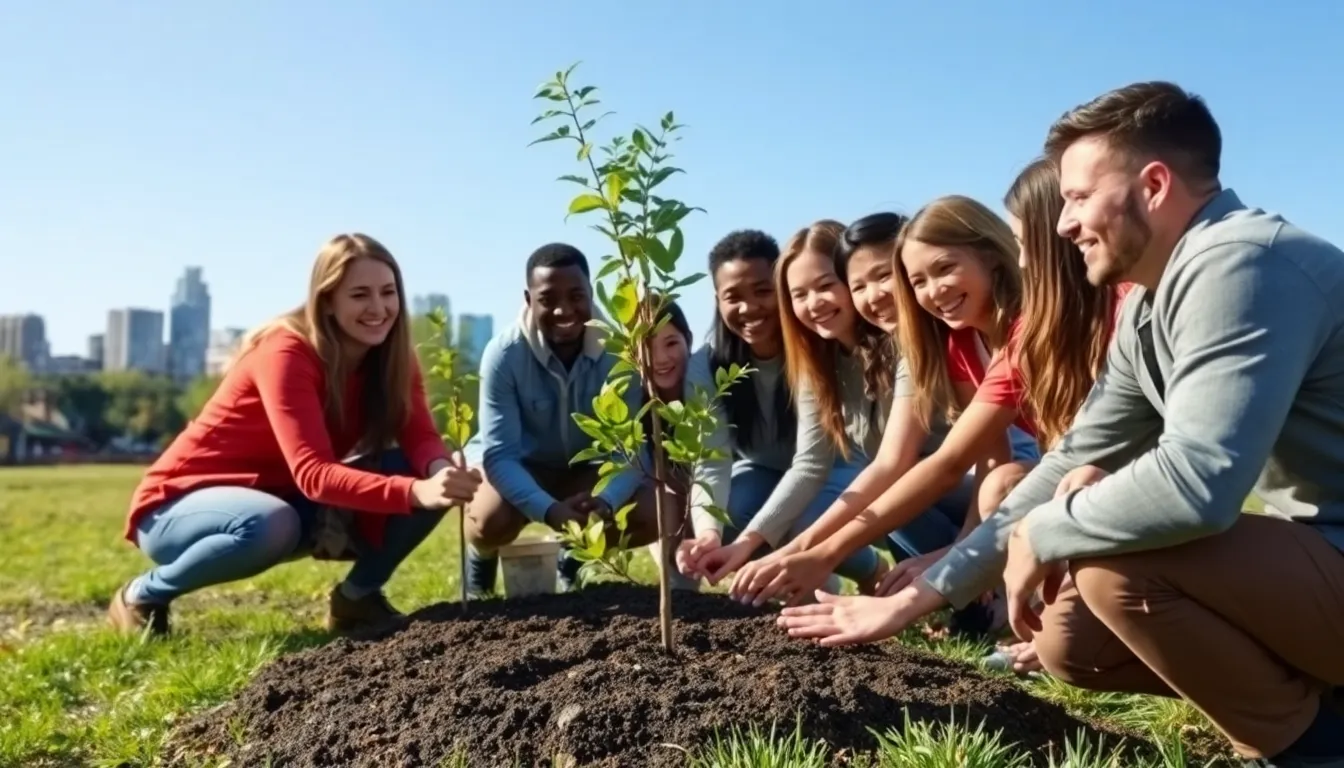In a world that often feels like it’s drowning in doom and gloom, it’s time to hit the pause button and celebrate some environmental good news. Yes, you heard that right! Mother Nature has been throwing a few curveballs our way, but amidst the chaos, there are glimmers of hope that deserve a spotlight. From innovative green technologies to communities rallying together for sustainability, there’s a treasure trove of positive stories waiting to be uncovered.
Imagine a world where clean air isn’t just a luxury, but a daily reality. Picture cities transforming into lush green spaces instead of concrete jungles. It’s not just wishful thinking; it’s happening right now! Join the journey to discover the uplifting tales that prove it’s not all bad news out there. Get ready to feel inspired and maybe even chuckle a bit as we dive into the bright side of environmental progress.
Table of Contents
ToggleOverview of Environmental Good News
Positive environmental developments emerge regularly, showcasing advancements in sustainability. Green technologies gain traction, with solar energy capacity increasing by 23% in 2022, according to the International Energy Agency (IEA). Local communities engage in tree planting initiatives, resulting in millions of trees added to urban landscapes.
Innovative materials arise, such as biodegradable plastics that reduce waste. Many companies commit to net-zero emissions, setting ambitious targets for 2030. Electric vehicle sales soar, reflecting a 60% rise in US sales from 2021 to 2022.
Urban areas witness significant improvements in air quality due to the adoption of sustainable transportation solutions. Initiatives like car-free days and expanded pedestrian zones contribute to cleaner air and healthier cities.
Wildlife conservation efforts flourish, with numerous species experiencing population rebounds, thanks to dedicated wildlife protection programs. National parks and reserves expand, providing safe habitats for diverse ecosystems.
Collaboration between governments and organizations advances significant policies addressing climate change. Investments in renewable energy create jobs, with solar and wind sectors demonstrating high growth rates.
Environmental education programs empower individuals to make sustainable choices in their daily lives, promoting awareness about recycling, energy conservation, and biodiversity. People become more engaged in sustainability efforts, leading to a collective shift toward more eco-friendly practices.
These examples serve as proof that positive change is achievable and ongoing in addressing environmental challenges. Recognizing and celebrating these good news stories fosters hope and encourages continuous action toward a sustainable future.
Innovative Solutions for Sustainability

Innovative solutions are transforming sustainability practices globally. Numerous advancements showcase how technology and collaboration drive positive environmental change.
Renewable Energy Advancements
Renewable energy sources saw a remarkable 23% boost in solar energy capacity during 2022. Electric vehicle sales surged by 60% across the U.S. from 2021 to 2022, highlighting the shift towards cleaner transportation. Wind power is also gaining traction, with new installations increasing significantly, contributing to cleaner energy grids. Cities are investing heavily in solar and wind projects, creating jobs and reducing carbon footprints simultaneously. This collective effort positions renewable energy as a key player in combating climate change.
Eco-Friendly Technologies
Innovative eco-friendly technologies are emerging to reduce environmental impact. Biodegradable plastics are becoming mainstream, with companies dedicated to sustainable materials. Smart home devices are now designed to optimize energy use, enhancing efficiency. Innovative water filtration systems help communities access clean water while minimizing waste. Additionally, many businesses are adopting circular economy principles, recycling materials into new products. These technologies foster environmentally conscious consumer behavior, reinforcing sustainability goals.
Conservation Success Stories
Celebrating conservation achievements highlights humanity’s positive impact on the environment. Success stories demonstrate effective preservation and restoration efforts worldwide.
Wildlife Protection Initiatives
Many wildlife protection initiatives are making significant strides in species recovery. Governments and organizations have implemented measures to safeguard endangered species, leading to increased populations of various animals. For instance, the gray wolf population in the U.S. rose from 1,000 in 1995 to over 6,000 by 2022. In regions like Africa, anti-poaching efforts have reduced elephant poaching by 30% since 2015, allowing populations to stabilize. Additionally, marine conservation areas have protected vital habitats, aiding species such as sea turtles. This collective approach emphasizes the crucial role of legislation, community involvement, and research in preserving biodiversity.
Restoration of Natural Habitats
Restoring natural habitats has become a priority for ecological balance. Projects focus on reforesting areas previously impacted by deforestation, resulting in a surge of native species returning to their ecosystems. In 2022, restoration efforts in the Amazon restored over 50,000 acres of rainforest, promoting carbon sequestration and biodiversity. Wetlands are also receiving attention; initiatives have revitalized coastal regions, enhancing resilience against climate change impacts. Cities are reclaiming industrial sites for green spaces, improving urban ecosystems. These targeted efforts highlight the importance of fostering healthy environments for wildlife and communities alike.
Community Engagement and Education
Community engagement and education play crucial roles in fostering environmental awareness. Success can flourish through local initiatives and programs that empower individuals to contribute to sustainability.
Grassroots Movements
Grassroots movements ignite local action, connecting communities to environmental causes. Activists often rally support for tree planting events, clean-up efforts, and eco-conscious campaigns. A notable example includes the global movement to combat plastic pollution, which encourages grassroots organizations to engage residents in reducing single-use plastics. These efforts cultivate a sense of ownership and responsibility, ultimately leading to substantial environmental benefits. Participants not only make a difference in their local areas but also inspire others to adopt sustainable practices.
School and Youth Programs
School and youth programs instill environmental stewardship from an early age. Educational institutions often incorporate sustainability into their curricula, promoting topics like renewable energy and conservation. Programs, such as school gardens, engage students in hands-on learning about ecosystems and healthy food sources. Involvement in competitions, like recycling challenges or conservation contests, further encourages young people to think critically about their environmental impact. These initiatives build a foundation for eco-conscious habits, preparing future generations to tackle pressing environmental issues effectively.
Government and Policy Changes
Governments worldwide are making significant strides in environmental policy, showcasing commitment to sustainability through various agreements and local legislation.
International Agreements
International agreements play a crucial role in uniting nations to combat climate change. The Paris Agreement aims to limit global warming to below 2 degrees Celsius, with countries pledging to reduce greenhouse gas emissions. In 2022, countries reaffirmed their commitments, resulting in enhanced cooperation toward sustainability goals. These collaborative efforts include financial mechanisms for developing nations to adopt greener technologies. Additionally, the Global Biodiversity Framework targets the protection of at least 30% of the world’s natural ecosystems by 2030, emphasizing the need to protect biodiversity and promote sustainable development.
Local Legislation for Environmental Protection
Local legislation increasingly addresses environmental protection, empowering communities to enact meaningful change. Cities across the U.S. have adopted policies promoting renewable energy usage and regulating waste management practices. Recent data shows that more than 200 cities have committed to 100% renewable energy by 2035. In parallel, initiatives banning single-use plastics are gaining traction, with numerous states implementing restrictions within the next few years. These regulations foster a culture of sustainability at the community level, encouraging individuals to engage in environmentally friendly practices and supporting local economies focused on green technologies.
Positive environmental developments are reshaping the narrative around climate change. From the surge in renewable energy to successful wildlife conservation efforts, there’s a growing sense of optimism. Communities are actively participating in sustainability initiatives and embracing eco-friendly technologies that reduce carbon footprints.
These collective actions underscore the potential for meaningful change when individuals, organizations, and governments collaborate. As awareness and education continue to spread, future generations are better equipped to tackle environmental challenges. The path toward a healthier planet is illuminated by these successes, inspiring hope and encouraging continued progress in fostering a sustainable world.


